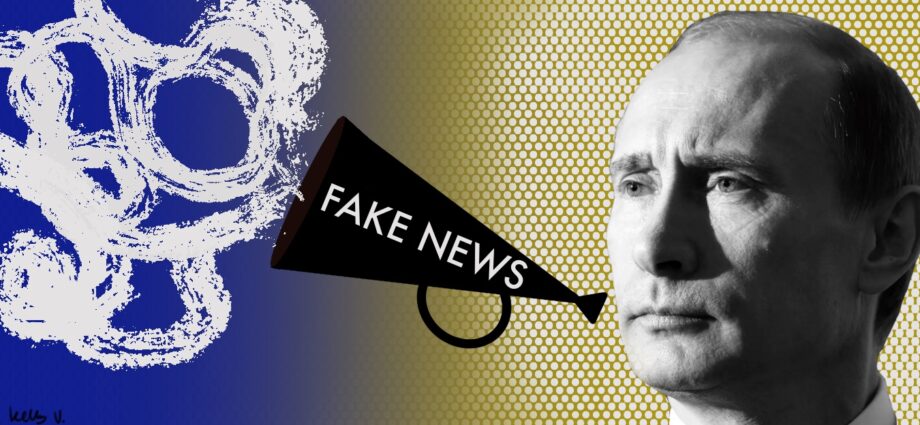By Zuzanna Mietlińska & Joanna Sowińska
While the large-scale invasion of Ukraine in 2022 surprised more than one, information on the war can be found on a wide spectrum of different sources. Ranging from press, television, but also social media, graphic images of the bombings and the wounded are shocking. Positive emotions such as compassion emerged, especially in regard to the fleeing families and the reaction of states providing humanitarian help in the form of shelter, food, medication and military equipment. In this context, the multilevel help of both governmental-affiliated entities, as well as common human beings regarding an imminent humanitarian crisis is evident.
However, in this sea of information and imagery float very misleading narratives on the situation in Ukraine. With the speed of social media and easily shareable information, the prominence of fake-news expanded, resulting in fallacious echo-chambers.
According to an analysis of MIT Media Lab:
“Truth needs, on average, 6x more time than fake news to spread among 1500 people on Twitter, and untrue/sensational messages have on average 70% more chance to be retweeted than the true one. Most often, the reproduced fake news are political”.
That is, some information can be used in a way to control one’s emotions and thus behaviour. Without fact-checking the information given in the media, it is easy to fall into the trap of exporting dangerous ideas. Accordingly, disinformation campaigns on the situation in Ukraine grew over 20000%, notably due to fast-sharing on social platforms. Images of the war, which are meant to shock, are sometimes meant to confuse as well – and are often used by both sides of the conflict. In this regard, sheer propaganda is an element of the so-called hybrid war – and the Kremlin has tremendous human and technological capacities to take part in it. What can be concluded is that war news and images spread are a form of a tragic weapon – the disinformation war.
The Snake Island Battle
Firstly, it has been observed that disinformation comes from various sources and sides – and when even verified news outlets spread falsified narratives, one can realize the scale of the issue. A relevant example illustrating the reach of disinformation is the story of the Ukrainian Soldiers of Snake Island.
On 24.02, Ukrainian Border guards announced that the island of Ostriv Zmijinyj (eng. Snake Island) was attacked by Russian naval ships in the early afternoon hours. When the Russian warship crew demanded that the thirteen Ukrainian soldiers stationed on the island surrender, their response was: “Russian warship, go f*ck yourself!“(rus. “Русский военный корабль, иди нах*й!”). This eventually resulted in rumours about their death.
Minutes later, mainstream media not only depicted the bravery of the Ukrainian soldiers and framed the quote as a battle-motto, but most importantly outlined the following news: the Russian warship killed the Ukrainian Soldiers of Snake Island. The information was shortly confirmed on Twitter by the Ukrainian president, Volodymyr Zelensky, and many journalists who saluted the soldiers and condemned their death.
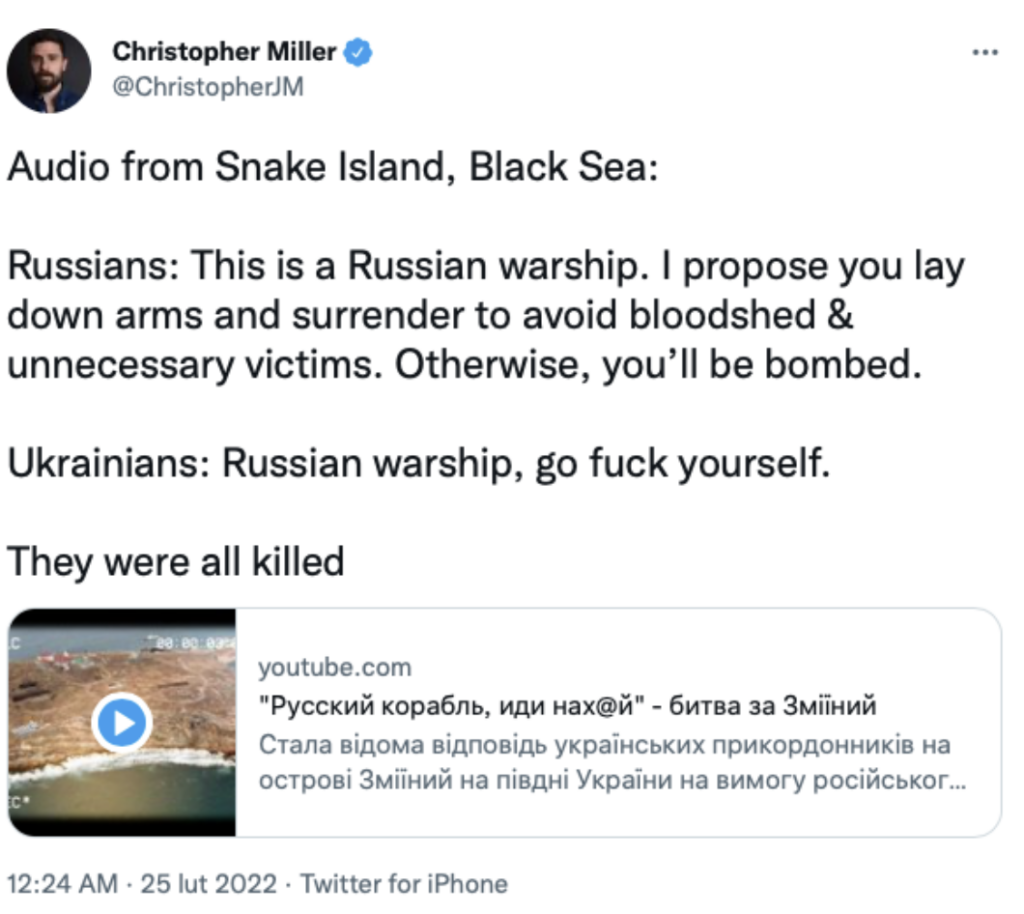
Moreover, a significant amount of social media posts spread this information, which reinforced the sentiment of compassion for the Ukranians. Nevertheless, on Monday 28.02, the Ukrainian Naval Forces shared information that the Ukrainian Soldiers of Snake Island are alive and under Russian hostage.
It is important to note that war has many faces, one of which is psychological warfare. The timeline of information spread in various media can be outlined as follows. From the beginning, the Russian side of the conflict shared the information that the Ukrainian soldiers on Snake Island had “surrendered”. On Monday 28.02, Ukrainian Naval Forces shared the following information on Facebook:
“Our brothers-in-arms are alive and well!” – confirming the restorative news – “border guards and marines on the island twice bravely repulsed the attacks of the Russian occupiers”, they added. The following information on the circumstances of the Snake Island “scenario” were published and phrased in a different way: rather than giving up, the soldiers would continue fighting until “they ran out of ammunition”. This sheds light on a delicate issue of high/low morale of the Ukrainian army — there’s a big difference between just giving up and fighting for as long as it is still possible. The issue can thus be seen and perpetuated by both sides of the conflict.
On the one hand, the Russians quickly debunked the death of the soldiers and border guards fighting on the Island, as their death would mean not only a violation of human rights but also an admission of a war crime. So far, the indiscriminate cluster bombs, banned by the Geneva convention, were reportedly used by Russian troops to attack a preschool in Okhtyrka, a current shelter for civilians.
What is also important to note is that this information was confirmed by Amnesty International and in the context of the Russian invasion as “a manifest violation of the United Nations Charter” and “an act of aggression that is a crime under international law”.
On the other hand, the possible Ukrainian reluctance of admitting that soldiers and border guards are still alive might be dictated by the above-mentioned morale issue. The brave resisters’ death grew into a veritable symbol – the symbol of the struggle against the Russian occupiers. As the “go f*ck yourself” symbol, it functions as a sign that united Ukrainians under a common enemy and is a way of demonstrating one’s political affiliations and sovereignty.
It is important to note that the difference between both narrations may be dictated by a kernel of truth in both of them. To this day, there’s no full confirmation on the details concerning the battle. There’s no need to clarify which side is the aggressor and which is the victim – but logical fallacies and “half-truths” can be found on both sides of the conflict. Both sides are promoting (more or less) beneficial images of reality in order to boost the soldiers’ morale.
Nevertheless, the story continues to encourage Ukrainians to fight for their freedom and political independence, e.g. promoting the campaign in the Ukrainian media of removing signposts in order to increase the localization problems for the Russians.
Ethnic and racial minorities on the Ukrainian-Polish border
Another major disinformation problem around the current situation in Ukraine is the discussion about alledged racial discrimination in regard to the entry of migrants and asylum-seekers on the EU territory. A number of different Tweets shared via Twitter and Instagram impose the idea of unequal treatment with regards to one’s ethnic background. Examples of such Tweets and posts are circulating in both Europe and the United States can be seen below:
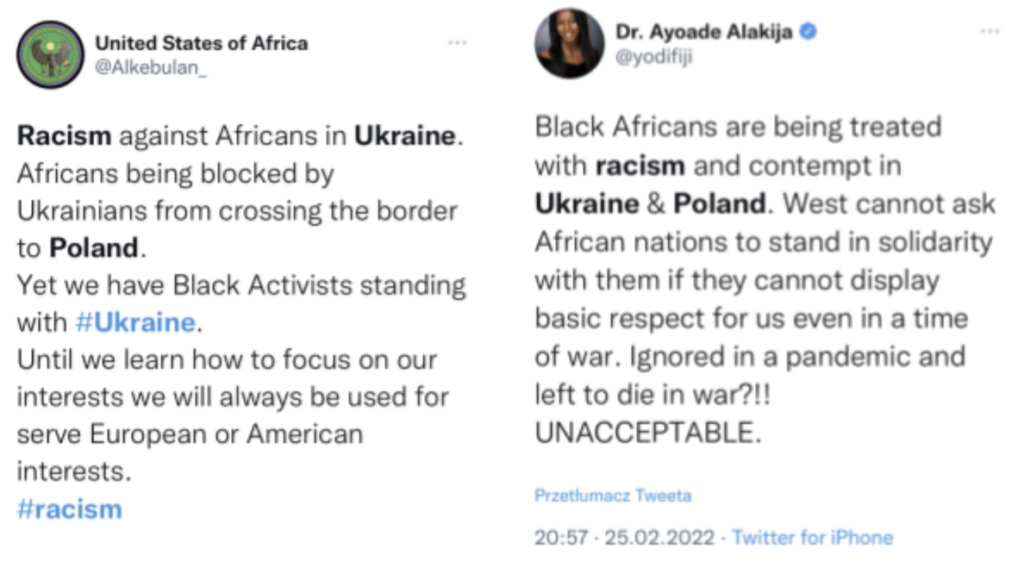
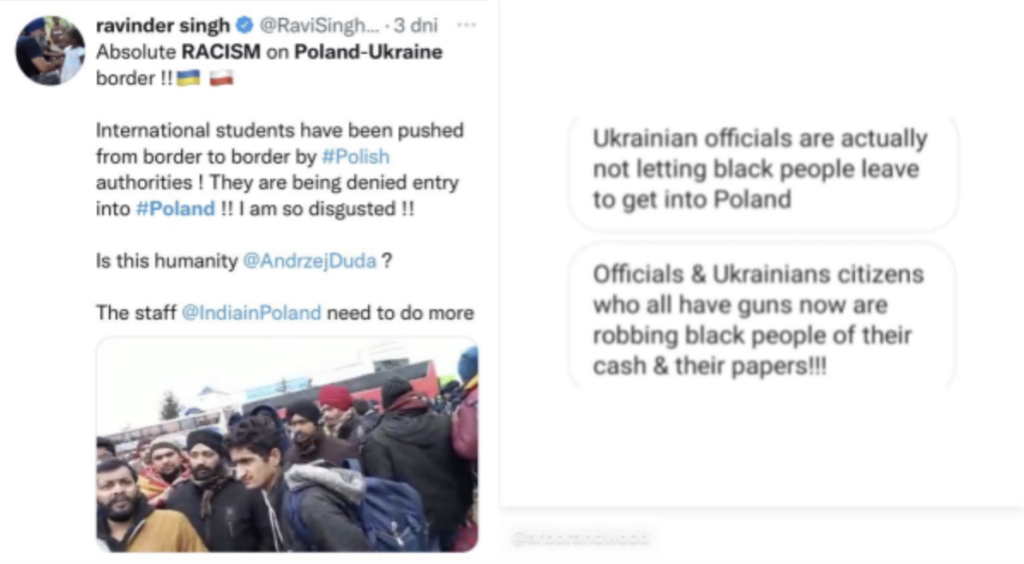
The occurrence of non-Ukrainians trying to cross the Ukrainian-Polish border is a delicate issue. Due to relatively low costs of living, there are over 70 000 young people in Ukraine from such countries as India (>18 000), Morocco (nearly 9 000) and Egypt (>3 000), but also the US, Nigeria, Georgia and other countries.
As The Ministry of the Interior and Administration of the Republic of Poland has recently informed:
“The dominant group of refugees in Poland are the citizens of Ukraine (…). All persons admitted to Poland are verified by the Border Guard. In relation to those who are “in doubt”, e.g. do not have documents, Border Guard officers apply appropriate checking procedures.
Any person who has received refuge in Poland will not be sent back to a war-torn state”.
The Institute of Research on the Internet and Social Media has warned about the emerging hashtag #AfricansinUkraine – that:
“Such information is a part of a dynamic desinformation operation targeted at the discreditation (…) of Poland and Ukraine in the international sphere in the topic of asylum-seekers”.
In other words, the hashtag and related posts to it, would simply be part of the disinformation campaigns launched by the Kremlin. The end result is thousands of posts spread by unaware social media users.
The reach of disinformation campaigns on ethnic and racial minorities on the Ukrainian-Polish border did not stop on social media but also reached traditional media. Accordingly, on Monday 28.02, BBC released material showing the story of a Nigerian student crossing the Ukrainian-Polish border and thus being treated badly by Ukrainian officials. “If your skin is dark, you’re at a disadvantage” – the Nigerian student said. Similar narratives were disseminated by CNN. Another material from the Ukrainian-Polish border was also released by the BBC. It presented a vague statement of a Nigerian student:
“Last day in Ukraine was very very difficult for me… The military there was very mean”.
However, the editing of the video does not show a full declamation of the student, and was called biased by such journalists as Kasia Madera, also working for BBC:
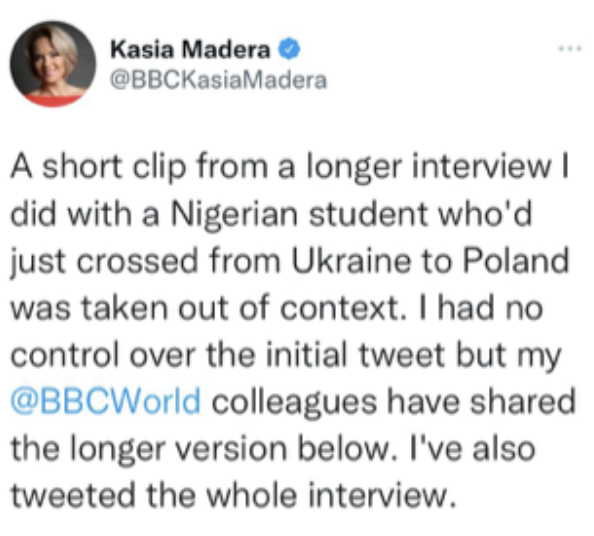
The picture of unequal treatment of BPOC was then denied by many journalists reporting from Ukraine. One must be cautious when watching such materials. As in this example, it lacked important details, such as who the perpetrators were. What is also important to say is that individual acts of alleged racism whether true or not can be easily used as a weapon to create and strengthen a harmful image of reluctant help towards BPOC of all Ukrainians in general. The anti-Ukrainian discourse and fake news about Ukraine is a fact – confirmed by many fact-checking NGOs. What is to emphasize here, is that hasty generalisations are never an answer to the problem – and rarely do they represent the whole reality concerning the ongoing war.
Back to the story of Nigerians on the Ukrainian-Polish border, a broader preliminary communication conducted by the BBC when in contact with the same student from Nigeria, currently in Ukraine, was also shared. The reported empty shops and long queues to pharmacies shed more light on the matter, as it concerns all people present in Ukraine equally.
The Chancellery of the Prime Minister of Poland officially deflects and condemns any form of racial distrimination on Ukrainian-Polish border:
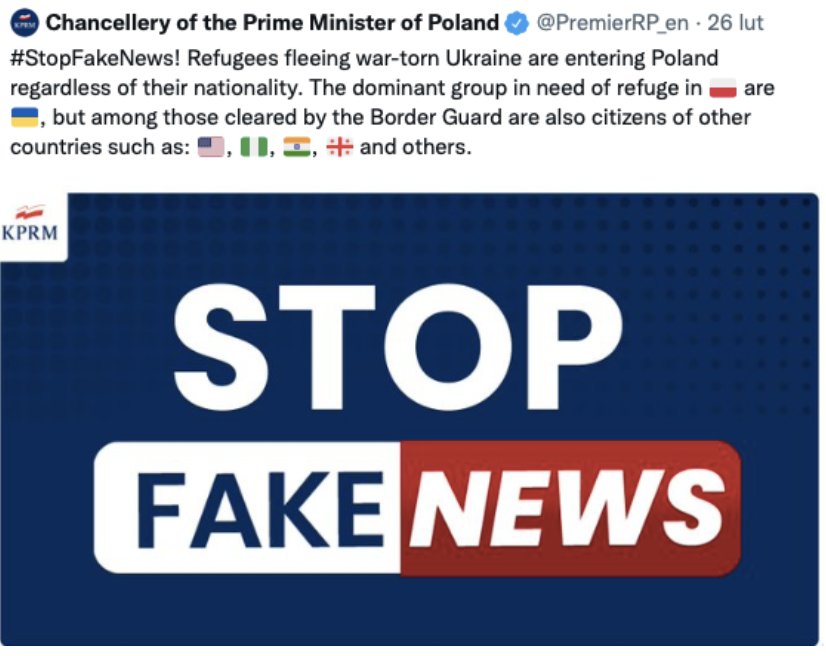
What is more, positive, rather than negative or neutral, videos concerning the minorities’ situation at the Ukrainian-Polish border can also be seen on social media. A good visual example of the above is a video material found here. What the author emphasizes on is not a “Ukrainians first” policy of the Ukrainian Border Control officials but rather a “women and children first” attitude. Such videos can add up to a full, complex picture of the racial problematics on the Ukrainian-Polish and other borders. The situation is equivocal.
In the discussion, it is important to note the position of the Nigerian Ministry of Foreign Affairs:
“it has received assurances from its counterpart in Ukraine that all foreign citizens are able to leave Ukraine freely without any obstacles”
On it’s website, the Embassy of Nigeria in Poland ensures the following:
“Collecting Nigerians from all the border crossings and entry points, as well as railway stations in Poland; placing those collected in arranged shelters, and would subsequently be providing evacuation aircrafts that would take them safely back to Nigeria”
Moreover, an official statement from the Embassy also ensures that the situation is taken under control by multilateral cooperation between Nigeria, Ukraine and its neighbouring countries:
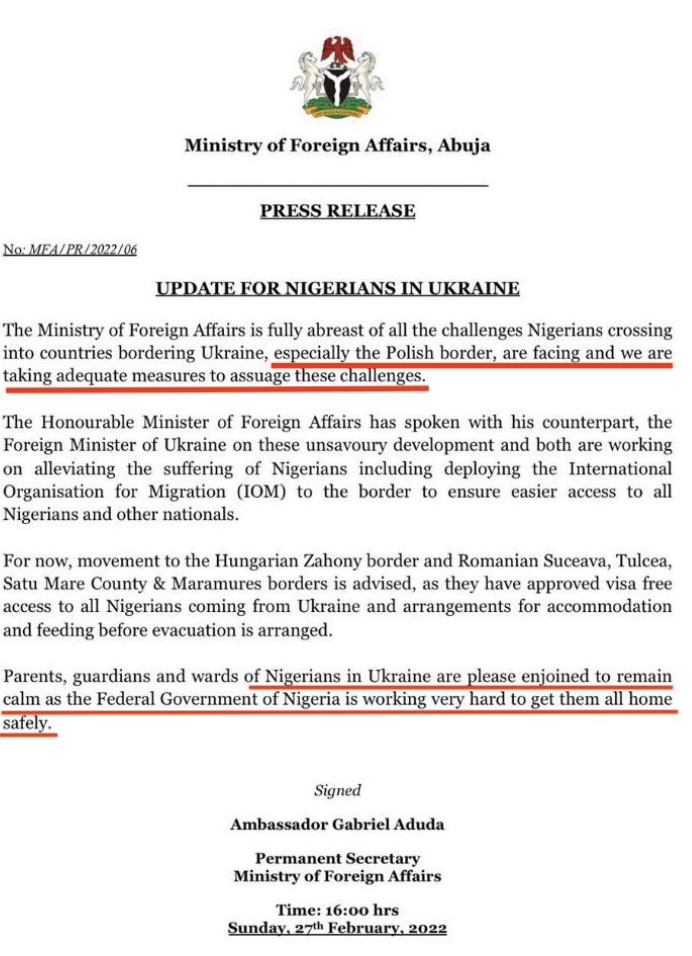
In the similar context of India, its Embassy in Warsaw states that it sends buses to the Ukrainian side of the border with the purpose of safely transporting Indian citizens to Poland. Moreover, the Embassy document clearly indicates the pick up point of the buses, which are exclusively reserved to Indian citizens and ensures that the operation will continue until every Indian is evacuated.
Although the official statements also cannot be fully trusted as their formality is meant to steady one’s nerves, it can be emphasized here that the institutions that provide such information are also, directly or not, in charge of the respective citizens’ safety. It is very important to take their actions into account when discussing the complex situation on the Ukrainian-Polish border. Therefore, one should be careful when sharing the unvalidated content via social media. Firstly, in the everchanging war-environment, information gets outdated quickly, and secondly, it is important to take all the actors involved in shaping this information.
So, what can I do, as a news consumer & social media user?
Raising your voice is important, and social media is a great tool to raise awareness on important issues. However, sharing researched and correct information from verified sources is essential, especially during crises.
The benefits of social media, especially in terms of its speed, not only allowed to quickly inform the public and pressure the politicians to act upon the issue, but also transformed into a very dangerous area of disinformation with serious consequences. Within a “click” on your screen or mouse, often indiscriminately, we share unverified materials. What can be the result?
To name a few, disinformation severely harmed the legitimacy of Ukranian media, such as the case of Snake Island where social media actively spread rumors that turned out to be misleading, or the alledged racial discrimination on the Ukranian-Polish border. The use of outdated graphic materials to make such statements can significantly undermine the solidarity of the countries, and therefore create political fragmentation – something Putin aims for. The international community especially warns about the massive flag operation launched by Russia to accuse Ukraine of human rights abuses. Regarding ambiguous photos and videos, Google Images provides help when fact-checking which images are directly concerning current affairs, and which are either paid by disinformation specialists or are shared by bots.
For this reason, make sure to not only question the material available on legitimate news outlets, but also carefully scrutinise the source of the content posted on social media. Do not give in to compulsive posting based on unchecked emotional posts that frustrate you. As claimed by Cindy Otis, a disinformation researcher and former CIA analyst:
“It’s too early to tell how effectively the Ukrainian efforts to debunk Russian disinformation narratives are working”, she says, “noting that their success will depend on whether they’re breaking through to their intended audience.”
Therefore, only time will show how far the disinformation war can reach.
Further reading:
https://mitsloan.mit.edu/ideas-made-to-matter/how-to-fight-pro-russia-disinformation-ukraine
https://www.researchgate.net/publication/280922184_Russia%27s_Hybrid_Warfare_A_Success_in_Propaganda
Edited by Karolina Hajná, artwork by Kelly Ville

